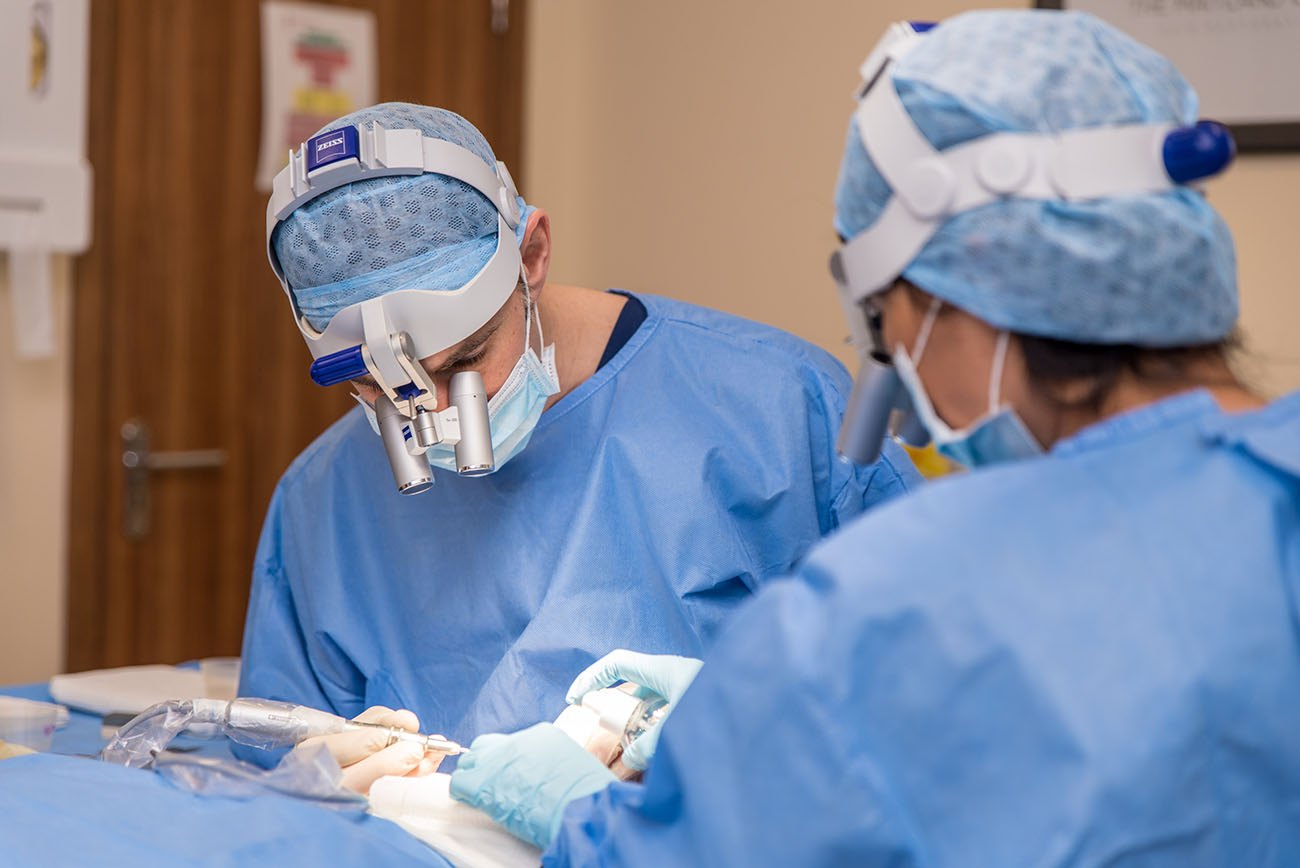Hair transplant side effects: risks and what to expect
5th October 2024

Key takeaways:
- Hair transplants have become an advanced long-term solution for hair loss, with modern techniques like Follicular Unit Excision (FUE) and Follicular Unit Transplantation (FUT)/linear strip excision.
- Common side effects immediately after the procedure include mild pain, swelling, oozing, and redness.
- Short-term side effects may include temporary hair shedding, itching, and a small risk of mild infection.
- Long-term effects could involve poor hair growth, scarring and temporary numbness, though these are often minimised with expert care.
- Serious hair transplant side effects such as infection, allergic reaction, and skin necrosis are very rare.
- Choosing a skilled and ethical clinic is vital to reduce the risk of complications and ensure a personalised, natural outcome.
Hair transplants have evolved into a sophisticated and effective solution for those suffering from hair loss. Modern hair restoration techniques, such as Follicular Unit Excision (FUE) and Follicular Unit Transplantation (FUT)/strip, allow people a chance to regain their hair and confidence.
However, like any surgical procedure, hair transplants come with potential side effects and risks. Understanding these effects can help you prepare for the procedure and manage your recovery effectively.
In this blog, we’ll walk you through everything you need to know about the side effects of a hair transplant, including the risks involved and how to manage your recovery.
What is a hair transplant?
Before diving into hair transplant side effects, it’s essential to understand what the procedure involves. Hair transplantation is a surgical procedure that involves removing hair follicles from one area of the body, typically the back or sides of the scalp (known as the donor area), and transplanting them to areas where the hair is thinning or balding (the recipient area). The hair from the donor area is genetically programmed to grow permanently, and so when transferred to the recipient area, these donor hair follicles encourage new hair growth.
Two primary techniques are used in hair transplants:
- Follicular Unit Transplantation (FUT): Involves removing a strip of skin with hair follicles from the donor area, then dissecting it into individual follicular units to be implanted one by one into the recipient area.
- Follicular Unit Excision (FUE): Involves individually extracting hair follicular units from the donor area and transplanting them one by one into the recipient site. This technique leaves small dot scars rather than the linear scar of FUT.
Who is a candidate for a hair transplant?
Not everyone with hair loss will be a candidate for a hair transplant because it may not be the safest or most effective option available. At The Maitland Clinic, we assess several suitability factors, including:
- Availability of your donor hair and if it’s enough to create a natural-looking result
- Cause of your hair loss
- Overall health and whether surgery will be safe and effective
- Age
- How stabilised your hair loss is
- How your hair loss may develop over time
- Hair transplant expectations and acceptance of an authentic result
Read more about who the best candidate is for a hair transplant.
Common hair transplant side effects
While the results of hair transplants can be life-changing, it’s important to be aware of the possible risks and side effects associated with hair transplant surgery.
Immediate post-operative side effects
Some common risks straight after a transplant include:
- Pain: Some patients experience mild pain which usually gets better within a day or two. Some people find the donor area uncomfortable for several days. Low-dose co-codamol tablets can be given for pain relief. The stitched donor area from FUT may be more uncomfortable than the FUE donor area, but each patient is different.
- Swelling: It’s common to have some swelling across the forehead and around the eyes after the procedure. Most patients have mild swelling, but in very rare cases, it can become more significant. The swelling occurs due to anaesthetic injections and the body’s response to incisions made for the hair grafts. Swelling usually peaks around 3 to 4 days after surgery and often resolves after 1 week. Swelling doesn’t impact the surgery’s success, but if your swelling doesn’t improve, let your transplant team know.
- Mild oozing: Some mild oozing may occur in the treated areas, which may be seen on the pillow overnight for the first 2 or 3 days. However, bleeding and scabs are rare because our technique involves matching the size of the hair grafts carefully to the incisions, reducing trauma and bleeding. Bleeding can sometimes occur if a hair graft is knocked or accidentally dislodged during the first week after surgery.
- Redness: The treated area might stay red for 10 to 14 days after surgery. At The Maitland Clinic, we often find that redness is less than patients expect and tends to resolve quickly. This is because we make the incisions as small as possible, reducing trauma. We also give all our patients a liposomal ATP aftercare spray, which provides the best environment for healing, graft survival, and accelerated recovery.
There are a range of other side effects that patients can experience. Before your procedure, we will make sure to talk you through the hair transplant side effects to expect so that you make a fully informed choice.
Short-term side effects
- Temporary shedding: Shedding or shock loss is when the natural, native hair falls in the area of the hair transplant. This happens because the transplant surgery causes some stress and inflammation to the scalp, which can disrupt the normal hair growth cycle. As a result, there can be some thinning in the treated area, but don’t worry – as long as the surgery hasn’t damaged the natural hair follicles, the hair will grow back over the next 3 to 4 months. Taking prescribed medications like finasteride or minoxidil may help reduce the chances of this temporary hair loss after the procedure.
- Itching: It’s common for healing skin to be itchy, but it’s important not to scratch the scalp after a transplant. The liposomal ATP aftercare spray tends to be very soothing for patients, and some people use moisturising creams a week after the operation, which can help reduce itching during the early healing period.
- Folliculitis: This is a condition where the hair follicles become inflamed. It can result after trauma to the hair follicles during the hair transplant, or may be due to ingrown hairs. It appears as small pimples on the scalp and may be itchy or sore. Folliculitis is not very common, is temporary, and unless severe, is unlikely to impact the outcome of your transplant. It is sometimes treated with antibiotics but usually resolves simply with the use of hot compresses on the affected area. It’s also important to follow aftercare hygiene instructions to help prevent folliculitis from forming in the first place.
- Infection: Infection after a hair transplant is very rare when the procedure is done properly and in a sterile environment. However, since the scalp can’t be completely sterile, there’s always a small chance of infection. Infections are more likely to happen in the stitched donor area from an FUT (strip) procedure, compared to an FUE transplant. Some doctors give antibiotics for a few days after an FUT transplant to lower the risk. If an infection does happen, it usually shows up 10 to 14 days after surgery and is quickly treated with a week of antibiotics.
Long-term side effects
- Scarring: Hair transplants will leave scarring in the donor area, but good surgical technique and surgical expertise can influence how visible the scar is to the naked eye. An FUT transplant will leave a linear scar where the ‘strip’ of skin is taken from the donor area. This is normally undetectable when the hair is worn at grade 4 or longer. An FUE transplant avoids a linear scar, but there will still be tiny dot scars left where incisions are made to extract the donor follicular unit grafts. When this transplant is performed by a highly skilled surgeon, the scarring is discrete and can be concealed when the hair is worn at grade 1 or 2.
- Numbness: Some patients may feel numbness in the area where the hair was transplanted or where the donor hair was taken. This numbness can last for a few weeks or even months. The scalp might feel a bit ‘dull’ to the touch for 3 to 9 months after surgery. Long-term numbness or scalp pain could happen if a nerve is damaged, but we haven’t seen this issue with any of our patients at The Maitland Clinic. We use sophisticated surgical techniques to protect nearby nerves and blood vessels, making bleeding or long-term numbness highly unlikely.
Are there any serious hair transplant side effects?
It’s rare to experience a serious side effect after a hair transplant, especially when hair transplants are performed by a highly skilled surgeon with expertise in the field. However, like with any surgery, there are some potential risks to be mindful of:
- Allergic reaction: It’s possible to be allergic to the drugs used during a hair transplant, but this is very rare. Allergies to local anaesthetics are uncommon and would be discussed during your initial medical assessment. All of our staff are trained to spot and treat allergies, including severe allergic reactions (anaphylaxis), which require immediate care. We have emergency medications and a resuscitation trolley in the clinic, which are checked daily and ready to use in the unlikely event of a medical emergency.
- Skin necrosis: Skin necrosis is a serious issue that can happen if a hair transplant damages the scalp and affects its blood supply, leading to areas of skin dying. This can result in thick scabs, ulcers, and slow healing. Research shows that this side effect is very uncommon, but people with poor blood circulation such as those with uncontrolled diabetes, heart disease, or who smoke, are at higher risk. Skin necrosis is also more likely to occur in hair transplant clinics where poor techniques and excessive grafts are often used. We’ve never encountered this problem at The Maitland Clinic and use various techniques to ensure the blood supply to the scalp is protected.
- Unnatural or inappropriate hairline: Having a hair transplant at an inexperienced clinic with limited focus on personalised care can lead to poorly designed and unrealistic hairlines. At The Maitland Clinic, we often see distressed patients from other clinics who want their unnatural hair transplant results corrected. This can be a complicated process that may cause additional trauma, scarring, and expense, and can be limited by the reduced amount of donor hair left after the initial unsuccessful transplant. This is why it’s essential to choose a high-quality hair transplant clinic with an experienced team.
Managing hair transplant side effects and risks
Choose a reputable clinic
Select a clinic with a proven track record and experienced surgeons. Expertise often correlates directly to outcomes, so make sure to research thoroughly before making a choice on the clinic for you.
Learn more about our world-class team at The Maitland Clinic.
Follow guidelines before and after surgery
Stick to any guidelines provided by your clinic before and after the surgery to minimise complications and optimise your results. This might include taking medications, attending follow-ups, or specific scalp care practices.
At The Maitland Clinic, prior to any procedure, we make sure to explain in detail what to expect after a hair transplant, including the side effects and how you can treat them, so that you can confidently manage your recovery. We go above and beyond to make sure you never feel alone and if you’re ever worried about the hair transplant side effects, you can contact our team at any time.
Hair transplants at The Maitland Clinic
Hair transplants are a safe and effective way to restore hair and confidence, but it’s important to understand the range of hair transplant side effects so that you can make an informed choice about your treatment.
Choosing the right clinic is crucial to minimising risks and achieving the best results. At The Maitland Clinic, our highly skilled and experienced team is committed to delivering natural, long-lasting outcomes with meticulous attention to every detail of your hair restoration journey.
If you’re considering a hair transplant or want to learn more about the hair transplant side effects, we’re here to help. Get in touch with us today to discuss your options and receive personalised advice from experts who prioritise your safety, comfort, and satisfaction.










